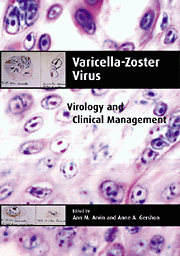Book contents
- Frontmatter
- Contents
- List of contributors
- Preface
- Introduction
- Part I History
- Part II Molecular Biology and Pathogenesis
- 2 Molecular evolution of alphaherpesviruses
- 3 DNA replication
- 4 Viral proteins
- 5 Pathogenesis of primary infection
- 6 Pathogenesis of latency and reactivation
- 7 Host response to primary infection
- 8 Host response during latency and reactivation
- 9 Animal models of infection
- Part III Epidemiology and Clinical Manifestations
- Part IV Laboratory Diagnosis
- Part V Treatment and Prevention
- Index
- Plate section
9 - Animal models of infection
from Part II - Molecular Biology and Pathogenesis
Published online by Cambridge University Press: 02 March 2010
- Frontmatter
- Contents
- List of contributors
- Preface
- Introduction
- Part I History
- Part II Molecular Biology and Pathogenesis
- 2 Molecular evolution of alphaherpesviruses
- 3 DNA replication
- 4 Viral proteins
- 5 Pathogenesis of primary infection
- 6 Pathogenesis of latency and reactivation
- 7 Host response to primary infection
- 8 Host response during latency and reactivation
- 9 Animal models of infection
- Part III Epidemiology and Clinical Manifestations
- Part IV Laboratory Diagnosis
- Part V Treatment and Prevention
- Index
- Plate section
Summary
Immunopathological studies of varicella-zoster virus (VZV) have long been hampered by the lack of a suitable experimental model that could mimic the clinical events observed during human infection. The virus is highly species-specific and does not replicate efficiently in nonhuman cells. In addition, VZV produced in vitro, even in human cells remains cell-associated and it is difficult to obtain the high titers of virus required to inoculate animals. Although many efforts have been made to infect laboratory animals belonging to various species, including non-human primates, human disease has never been reproduced in all of its manifestations. As a consequence, most investigations on the biology and the pathophysiology of the VZV, especially aspects concerning latency, had to be deduced from studies on herpes simplex virus (HSV), another human herpesvirus that shares with VZV the capacity to remain persistent in the nervous system and to reactivate. However, it is now obvious that the molecular mechanisms involved in VZV neurotropism and latency are different from those of the other alpha herpesviruses.
Although none of the animal models described so far is satisfactory to evaluate all aspects of VZV pathophysiology in humans, many of them are useful to investigate acute infection, the immune response or latency. Different models help to answer different questions.
Models of acute infection and the immune response
As early as 1926, although the varicella-zoster virus had not yet been isolated, Rivers reported a limited VZV infection after inoculation of emulsified vesicles and papules collected from a human chickenpox lesion into testes of green monkeys (Rivers 1926, 1927).
- Type
- Chapter
- Information
- Varicella-Zoster VirusVirology and Clinical Management, pp. 169 - 184Publisher: Cambridge University PressPrint publication year: 2000
- 1
- Cited by

